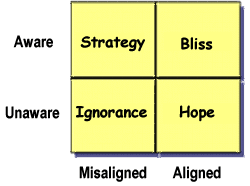Process Project Perspectives: Hope is not a Strategy and Ignorance is Not Bliss
"A different point of view is simply
the view from a place where you're not."~ From a series of posters sponsored by HSBC
in Heathrow Airport
Aligning Perspectives at the Beginning
In my experience, getting started is the hardest part of any process project. There are lots of unknowns and, at the same time, a lot of pressure to get it done fast since there is a deadline to be met or a system to be built. It is not until roadblocks are hit and differences of opinion clearly or subtly appear once underway that we realize that different people are using different criteria to object or to support the emerging solution. By then we are committed to dates and other teams are waiting in the wings. The pressure is enormous. Many of us start up and just get going with one of the vague intentions presented last month[1] and hope for the best. Figure 1 shows where hope lies.

Figure 1. Perspective Alignment
It is to be expected that each insider and outsider will have a view and a set of expectations by which each will advocate and judge the conduct and results of the process change. The first question we must ask ourselves is "Do we know what these are? Are we sure? How do we know?" If we are unaware of the various interests and do not take time to gain that understanding, then we will be at tremendous risk since surprises will surely come, usually downstream when we can least afford to deal with them. If we are aware of the different points of view we can at least have a plan to get them aligned if they are not already. Figure 1 shows a quadrant of possibilities that we may start with and implies an action plan for attaining our position of confidence and commitment to the effort at hand, depending on the going-in position of awareness and alignment.
It is safe to assume that when starting up a process initiative, not all points of view, interests, and judgment criteria will be known. We will all be unaware of one another's criteria even if we think we are aware. Let's take each quadrant in order.
Hope
I will deal with this quadrant first since it represents some form of delusion on behalf of those who start here. It basically says that we just start off in the project without dealing much with why we are doing what we are doing and what represents success for all, and that everyone somehow magically will agree so we do not have to address the risk of being wrong. If our assumption of perfect fit proves to be true and we all agree on what's right, then that's pure luck. So ask yourself when you start a process initiative: "Do I feel that lucky?" Having said all this, many process projects start off in just that way, with little in the way of planning and alignment activities. As a result, many fail entirely or experience serious derailments along the way. Frequently, these unhappy outcomes are the result of the attitude that says: Do not waste time on alignment. Hurry up and get started. Do your best, and it will all work out somehow. It scares me.
Ignorance
This quadrant represents the typical starting reality. We are typically misaligned but do not know to what extent. Any experienced process practitioner will be pretty sure that at the outset of any process initiative there will be different goals from different people, although he or she will not know what they are at this point. The first step in each project then will be to discover the assumptions of each internal stakeholder, without judging them or attempting to change anything yet. Seek first to understand.
Strategy
Having gained an understanding of the misalignment inherent in any multifunctional process improvement initiative, and having conquered the ignorance we started with in the previous quadrant, it is now time to change some perspectives and get them aligned with our outsiders' perspectives. At this point, the Process Charter should be invoked and presented, gaining acceptance one point at a time from the top and working down. This step must occur before the process change project gets into analysis or design, since the charter provides the needed criteria that become the team's marching orders. The arguments resulting from unaligned perspectives are resolved at this point, having been understood and dealt with previously. The techniques to accomplish this will be critical since it will be difficult for some to get on the same page, especially if it's someone else's. There will be feelings and emotions to deal with. Strategically, taking an outside-in approach by starting from outsiders' values to insiders' requirements and following the charter in team workshops is best practice. Clearly, but it will require effective facilitation.
Bliss
With an iron clad, documented Process Charter that has been agreed upon and signed off on by all insiders who can express their points of view, the project can begin with confidence. It will not be burdened down the line with the usual roadblocks — hidden agendas, changing opinions, outright subversion, thrashing, and surprises regarding how well the process is working, what we should use as measures, the causes of performance problems, and what constitutes an appropriate solution.
Conclusion
The biggest barrier in process projects and in day-to-day process performance management is lack of personal goal alignment with business and customer needs. When we ensure the project motivation model is personally aligned and remains visible, we will be OK. Developing a commonly-accepted Process Charter up front will serve up savings and peace of mind. So find a way to carve out time for this underappreciated work early on in the project.
That's how I see it.
References
[1] Roger
T. Burlton, "Process Project Perspectives: Outsiders and Insiders," Business Rules Journal, Vol. 11, No. 1 (Jan. 2010),
URL: http://www.BRCommunity.com/a2010/b519.html ![]()
# # #
About our Contributor:
Online Interactive Training Series
In response to a great many requests, Business Rule Solutions now offers at-a-distance learning options. No travel, no backlogs, no hassles. Same great instructors, but with schedules, content and pricing designed to meet the special needs of busy professionals.











How to Define Business Terms in Plain English: A Primer
How to Use DecisionSpeak™ and Question Charts (Q-Charts™)
Decision Tables - A Primer: How to Use TableSpeak™
Tabulation of Lists in RuleSpeak®: A Primer - Using "The Following" Clause
Business Agility Manifesto
Business Rules Manifesto
Business Motivation Model
Decision Vocabulary
[Download]
[Download]
Semantics of Business Vocabulary and Business Rules